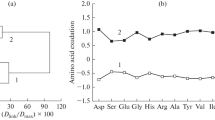Summary
Cotton-field soils from a wilt-free zone (KPT) and from a wilt-sick zone (PLD), and root exudates of diploid and amphidiploid cotton strains grown in KPT and PLD soils were analyzed for 13 free amino acids employing microbiological assay techniques. Test organisms used wereLactobacillus arabinosus 17/5 andLeuconostoc mesenteroides P. 60.
Arginine, proline, lysine, serine, glycine, cystine, and tyrosine occurred in both the soils; amounts of these were higher in PLD soil than in KPT soil.
Seven to eleven amino acids were found in the root exudates of cotton. Aspartic acid, threonine (in one), phenylalanine and leucine were found in root exudates but not in the control soils. Diploid strains were found to exude greater amounts of amino acids than the amphidiploid strains. Comparing the effect of the two soils tested, it was found that amino acids in exudates of plants grown in PLD soil were higher except in the case of one diploid strain.
In the inoculated series, amino acids in the exudates were markedly lower than the respective healthy controls in the diploid strains. In the exudates of amphidiploid strains also, amino acid contents were reduced but to a lesser extent.
Significance of occurrence of cystine in the exudates of some strains is indicated.
Similar content being viewed by others
References
Andal, R., Bhuvaneswari, K., and Subba-Rao, N.S., Root exudates of paddy. Nature, London178, 1063 (1956).
Barton-Wright, E. C., The Microbilogical Assay of the Vitamin B-Complex and Amino Acids. Sir Isaac Pitman and Sons Ltd., London (1952).
Bremner, J.M., The amino-acid composition of the protein material in soil. Biochem. J.47, 538–542 (1950).
Dadd, C. C., Fowden, L., and Pearsall, W. H., An investigation of the free amino-acids in organic soil types using paper partition chromatography. J. Soil Sci.4, 69–71 (1953).
Eliasson, L., Inhibition of the growth of wheat roots in nutrient solutions by substances exuded from the roots. Kungl. Lantbrnkshogskolans Annaler25, 285–293 (1959).
Forsman, B., Thesis, Institute of Physiological Botany, Univ. of Uppsala, Sweden (1955).
Frenzel, B., Zur Abgabe von Amino-säuren and Amiden an das Nährmedium durch die Wurzeln vonHelianthus annus L. Planta49, 210 (1957).
Fries, M. and Forsman, B., Quantitative determination of certain nucleic acid derivatives in pea root exudate. Physiol. Plantarum,4, 410–420 (1951).
Kandler, O., Papierchromatographischer Nachweis der Amino-säureausscheidungin vitro Kultivierter Maiswurzeln. Z. Naturf.66, 437–445 (1951).
Katznelson, H., Rouatt, J. W., and Payne, T. M. B., Liberation of amino acids by plant roots in relation to desiccation. Nature, London174, 1110 (1954).
Lakshminarayanan, K., Role of cystine chelation in the mechanism of Fusarium wilt of cotton. Experientia11, 388 (1955).
Lochhead, A. G., and Thexton, R. H., Qualitative studies of soil microorganisms, VII. The ‘rhizosphere effect’ in relation to the amino acid nutrition of bacteria. Can. J. Research, C25, 20–26 (1947).
Parkinson, D., Liberation of amino acids by oat seedlings. Nature, London176, 35–36 (1955).
Payne, T. M. B., Rouatt, J. W., and Katznelson, H., Detection of free amino acids in soil. Soil Sci.82, 521–524 (1956).
Payne, T. M. B., Rouatt, J. W., and Lochhead, A. G., The relationship between soil bacteria with simple nutritional requirements and those requiring amino acids. Can. J. Microbiol.3, 73–80 (1957).
Rovira, A. D., Plant root excretions in relation to the rhizosphere effect 1. The nature of root exudates from oats and peas. Plant and Soil7, 178–194 (1956).
Sowden, F. J. and Parker, D. I., Amino nitrogen of soils and certain fractions isolated from them. Soil Sci.76, 201–208 (1953).
Venkata Ram, C. S., Fusaria of Southern Indian Soils Doctoral Thesis. Univ. of Madras. (1954).
Virtanen, A. I. and Laine, T., Chemical nature of the amino acids excreted by leguminous root nodules. Nature, London.136, 756–757 (1935).
Winter, G., Humus und Pflanze: Die Wechselwirkung von Pflanze und Boden im Lichte neuester Forschungen. Orion17, 377–381 (1952).
Zachariah, A. T., Micro-ecology of soils of cultivated fields of South India with special reference to the occurrence and physiology of Fusaria. Doctoral Thesis, Univ. of Madras. (1949).
Author information
Authors and Affiliations
Additional information
Part of Doctoral thesis, University of Madras.
Rights and permissions
About this article
Cite this article
Sulochana, M.C.B. Amino acids in root exudates of cotton. Plant Soil 16, 312–326 (1962). https://doi.org/10.1007/BF01381342
Received:
Issue Date:
DOI: https://doi.org/10.1007/BF01381342




